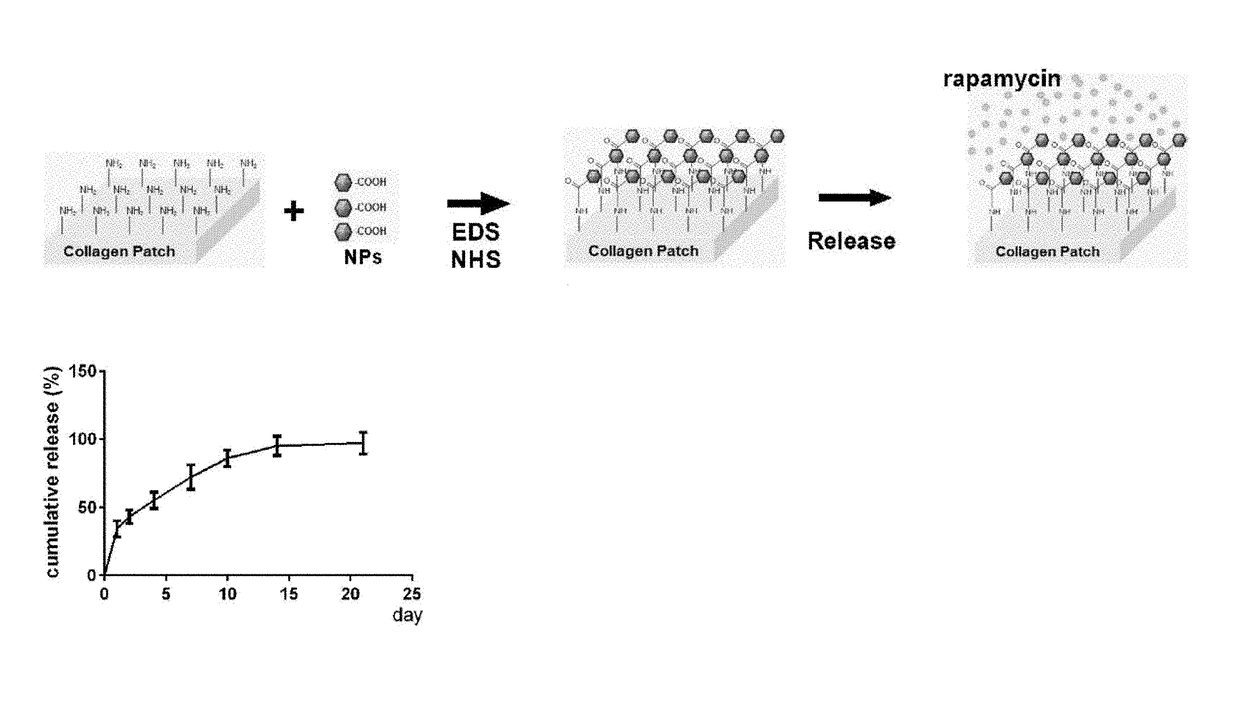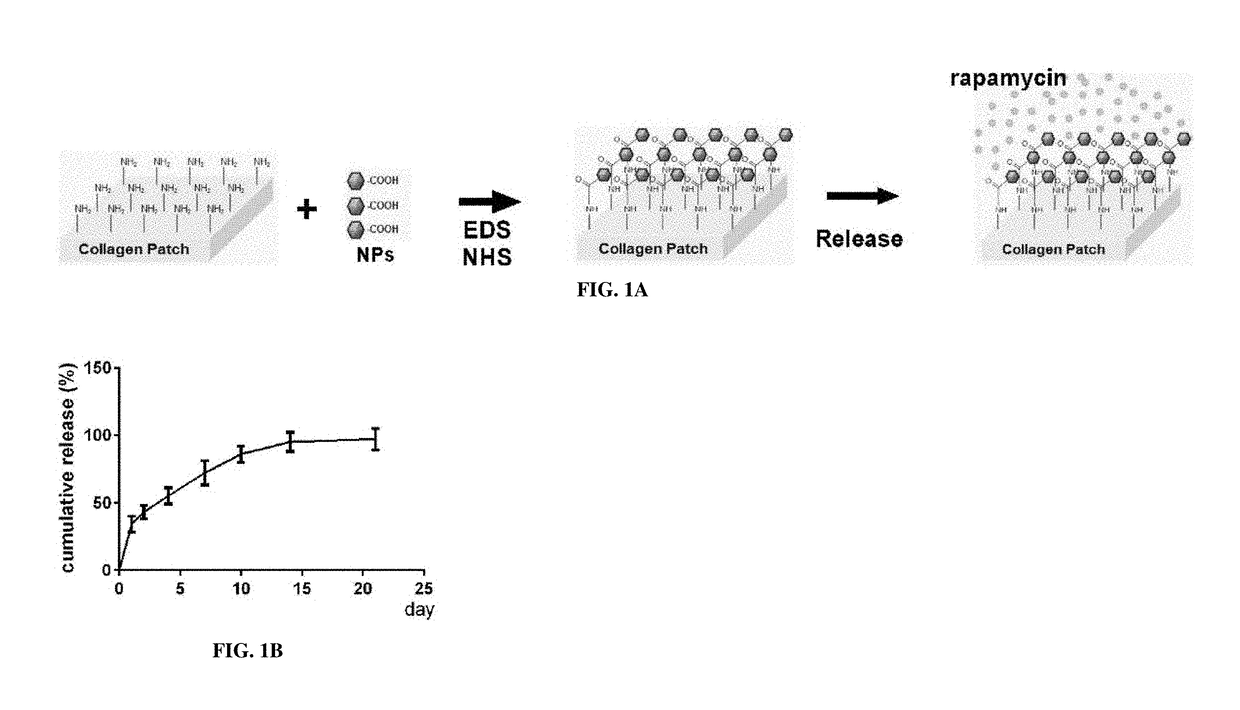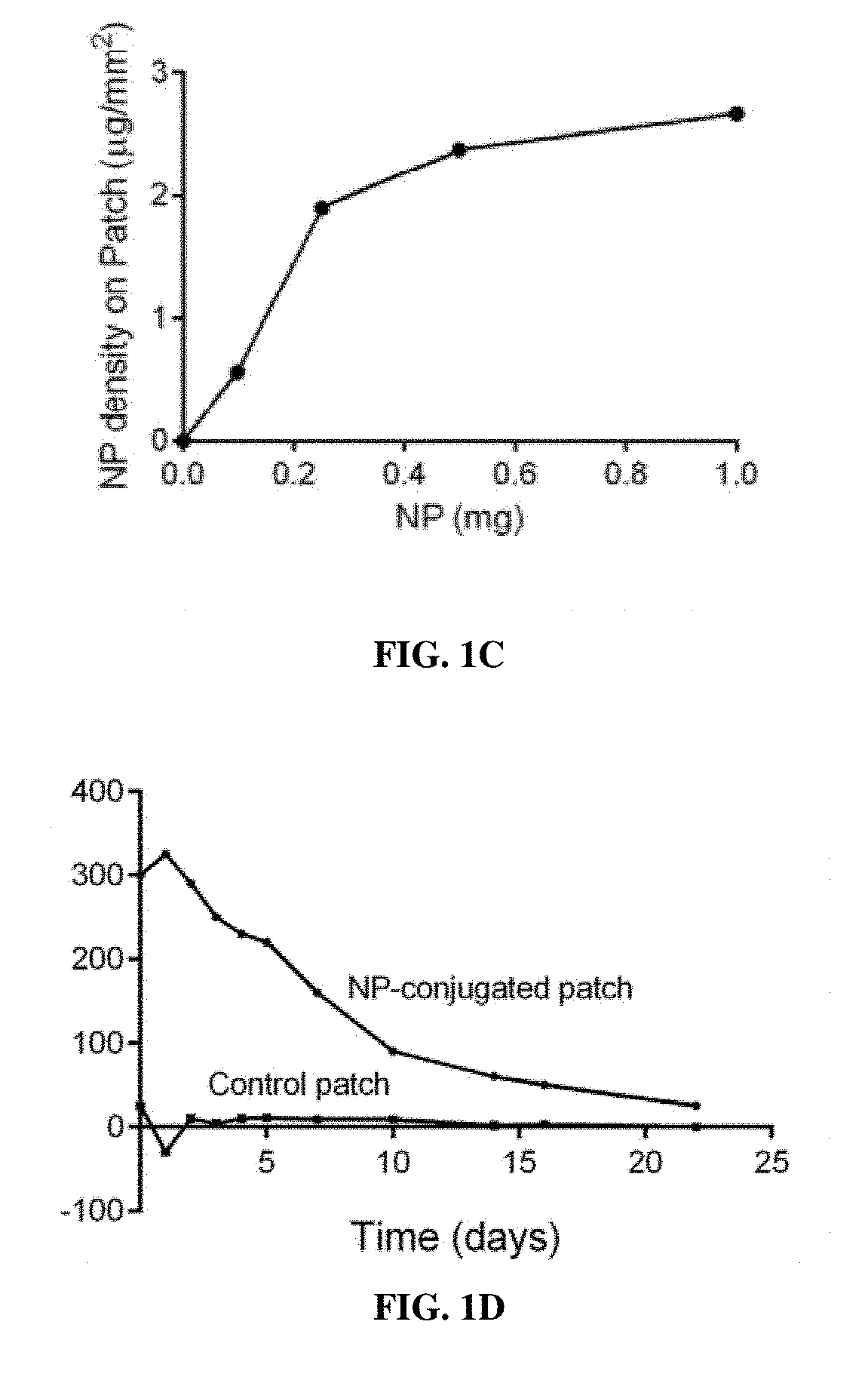Particle conjugated prosthetic patches and methods of making and using thereof
- Summary
- Abstract
- Description
- Claims
- Application Information
AI Technical Summary
Benefits of technology
Problems solved by technology
Method used
Image
Examples
example 1
on and Characterization of Nanoparticle-Patch Composites
[0248]Materials and Methods
[0249]Synthesis of Nanoparticles (NPs)
[0250]NPs were prepared using an emulsion method. Carboxylated PLGA (inherent viscosity 0.55-0.75 dL / g) (100 mg) and rapamycin (5 mg) were dissolved in chloroform, and then added drop-wise to 5% polyvinyl alcohol (PVA). The mixture was sonicated three times and then added to 0.2% PVA solution. The solvent was evaporated for 2 hours while stirring and the PLGA particles were centrifuged before lyophilization (Bal, et al., Sci Rep.; 7: 40142 (2017)).
[0251]The size and polydispersity Index (PDI) of the nanoparticles were measured using a Zetasizer (Malvern, Westborough, Mass.). Light scattering was measured by back-scattering at a detection angle of 173 and a wavelength of 532 nm; the hydrodynamic radius (RH) was calculated using the Stokes-Einstein equation:
RH=kBT6πηD0
[0252]where kB=Boltzmann constant, T=absolute temperature, η=solvent viscosity, D0=diffusion coeffi...
example 2
cle-Mediated Release of Active Agents from Pericardial Patches is Sustained for 15 Days and Inhibits the Proliferation of Smooth Muscle Cells In Vitro
[0260]Materials and Methods
[0261]Assessment of Active Agent Release from Patches
[0262]Patches conjugated with NP containing rapamycin (NP-rapamycin) were incubated in phosphate buffered saline (PBS) at 37° C. The supernatant of each sample was collected and analyzed for absorption at 400 nm at each time point using a SpectraMax plate reader (Molecular Devices, Sunnyvale, Calif.). Patches conjugated with NP containing rhodamine (NP-rhodamine) were incubated in PBS at 37° C.; control patches were incubated in PBS containing free rhodamine. At various time points patches were washed in PBS and their fluorescence intensity was measured.
[0263]Culture of Human Smooth Muscle Cells
[0264]Human smooth muscle cells (SMCs), passages 6-8, were cultured in endothelial basal medium 2, supplemented with endothelial cell growth media-2 MV SingleQuot Ki...
example 3
cle-Patch Composite Delivery System does not Introduce Toxicity to Lungs In Vivo
[0270]Materials and Methods
[0271]Rats were anesthetized with isoflurane inhalation, and tissues were fixed by transcardial perfusion of phosphate buffered saline (PBS) followed by 10% formalin. Tissue was removed and fixed overnight in 10% formalin followed by a 24-hour immersion in 70 percent alcohol. Tissue was then embedded in paraffin and sectioned (5 μm thickness). Tissue sections were de-paraffinized and stained with hematoxylin and eosin.
[0272]Results
[0273]FIG. 3A demonstrates that there is no decrease in proliferation in the lungs of rats that had NP-rapamycin patches implanted compared to control or NP-control patches. FIG. 3B demonstrates that there is also no increase in apoptosis in the lungs of rats that had NP-rapamycin patches compared to control or NP-control patches. Further, rapamycin was not present in detectable quantities in serum on days 1, 3 and 7 after implantation of NP-rapamycin...
PUM
| Property | Measurement | Unit |
|---|---|---|
| Time | aaaaa | aaaaa |
| Time | aaaaa | aaaaa |
| Mass | aaaaa | aaaaa |
Abstract
Description
Claims
Application Information
 Login to View More
Login to View More - R&D
- Intellectual Property
- Life Sciences
- Materials
- Tech Scout
- Unparalleled Data Quality
- Higher Quality Content
- 60% Fewer Hallucinations
Browse by: Latest US Patents, China's latest patents, Technical Efficacy Thesaurus, Application Domain, Technology Topic, Popular Technical Reports.
© 2025 PatSnap. All rights reserved.Legal|Privacy policy|Modern Slavery Act Transparency Statement|Sitemap|About US| Contact US: help@patsnap.com



